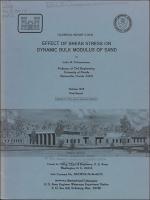Please use this identifier to cite or link to this item:
https://hdl.handle.net/11681/20595Full metadata record
| DC Field | Value | Language |
|---|---|---|
| dc.contributor | University of Florida. Department of Civil Engineering | - |
| dc.contributor | Soils and Pavements Laboratory (U.S.) | - |
| dc.contributor.author | Schmertmann, John H. | - |
| dc.date.accessioned | 2017-01-11T18:50:29Z | - |
| dc.date.available | 2017-01-11T18:50:29Z | - |
| dc.date.issued | 1978-10 | - |
| dc.identifier.uri | http://hdl.handle.net/11681/20595 | - |
| dc.description | Technical Report | - |
| dc.description | Abstract: The effect of shear stress on the magnitude and directional variation of the dynamic bulk modulus of sand was investigated by means of a program of laboratory measurements of P-wave and S-wave velocities under varied stress conditions. The sand used was air-dry Reid-Bedford Model sand and was tested at relative densities of about 25% and 80%. Test specimens were 4 ft high by 4 ft in diameter, formed by pluviation in air in a cylindrical pressure chamber. At each relative density, tests were done with values of octahedral normal stress of 5, 10, and 20 psi, and with σ₃/ σ₁ ratios of 1 and 1/3. Measurements of P-wave and S-wave velocities were made in three or four directions with accelerometers buried in the test specimens. The test results indicate that compression and shear wave velocities vary with direction in an isotropic stress field due to inherent anisotropy of the sand structure, but that this phenomenon has only a modest (0-20%) effect in producing anisotropy in the bulk modulus. The work tends to confirm, within +10%, that the shear wave velocity depends only on the level of octahedral normal effective stress and not on stress anisotropy. In contrast with the shear wave velocity, the compression wave velocity increases significantly in the direction of the major principal stress and depends primarily on the effective stress on the plane normal to wave travel. Values of bulk modulus, computed from the wave velocities under the assumption of elastic isotropy, show a variation with direction, which contradicts the assumption of isotropy. Appendix A contains photographs of typical oscilloscope waveforms from each replicate series of five impacts, and Appendix B presents tables of corrected V𝗉 and V𝗌, the push wave and shear wave velocities, respectively, from each test. NOTE: This file is large. Allow your browser several minutes to download the file. | - |
| dc.publisher | Geotechnical Laboratory (U.S.) | - |
| dc.publisher | Engineer Research and Development Center (U.S.) | - |
| dc.relation | http://acwc.sdp.sirsi.net/client/en_US/search/asset/1044470 | - |
| dc.rights | Approved for public release; distribution is unlimited. | - |
| dc.source | This Digital Resource was created from scans of the Print Resource | - |
| dc.subject | Bulk modulus | - |
| dc.subject | Compression waves | - |
| dc.subject | Shear stress | - |
| dc.subject | Shear waves | - |
| dc.subject | Sands | - |
| dc.subject | Sandy soils | - |
| dc.subject | Soil mechanics | - |
| dc.title | Effect of shear stress on dynamic bulk modulus of sand | - |
| dc.type | Report | en_US |
| Appears in Collections: | Technical Report | |
Files in This Item:
| File | Description | Size | Format | |
|---|---|---|---|---|
| TR-S-78-16.pdf | 32.99 MB | Adobe PDF |  View/Open |